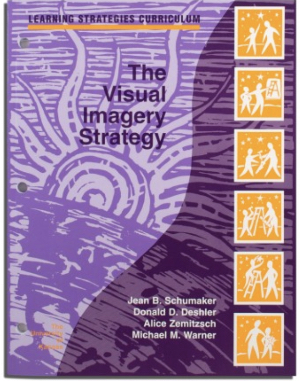The Visual Imagery Strategy

The Visual Imagery Strategy is a reading comprehension strategy for creating mental movies of narrative passages. Students visualize the scenery, characters, and action and describe the scenes to themselves as they read each sentence in a passage. Students use the strategy to improve their understanding and recall of specific facts and sequences.
In research studies, students showed average gains of 51 percentage points in reading comprehension of grade-level materials after they mastered the strategy.
Author(s):Jean B. Schumaker, Donald D. Deshler, Alice Zemitzsch, and Michael M. Warner
Publication Info: University of Kansas Center for Research on Learning, 1993
Resources:
- Research on the Visual Imagery Strategy (.pdf)
- Strategram Vol. 6, No. 6: Introducing The Visual Imagery Strategy (.pdf)
- Strategram Vol. 7, No. 5: Visual Imagery Bookmark (.pdf)
- Strategram Vol. 10, No. 5: Hands on Visual Imagery (.pdf)
- Strategram Vol. 11, No. 5: Visual Imagery activity, Terry Slockett Freese (.pdf)
Research Articles:
- Schumaker, J.B., Deshler, D.D., Woodruff, S.K., Hock, M.F., Bulgren, J.A., & Lenz, B.K. (2006). Reading strategy interventions: Can literacy outcomes be enhanced for at-risk adolescents? Teaching Exceptional Children, 38(3), 64-68. In two studies, students who learned reading strategies outperformed students who did not.
- Clark, F.L., Deshler, D.D., Schumaker, J.B., Alley, G.R., & Warner, M.M. (1984). Visual imagery and self-questioning: Strategies to improve comprehension of written material. Journal of Learning Disabilities, 17(3), 145-149. Two learning strategies, Visual Imagery and Self-Questioning, designed to increase reading comprehension were taught to six students with learning disabilities using a multiple baseline across strategies design on several outcome measures.
The Story Behind the Visual Imagery Strategy from author Jean Schumaker:
At the beginning of our work at the Institute for Research on Learning Disabilities in the 1970s, we did a descriptive study where we tested the academic skills of two groups of students at the junior high and high school levels: students who had been diagnosed as having learning disabilities (LD), and students who were receiving failing or barely passing grades on their report cards in subject-area classes (low-achievers). We learned that both groups of students had severe reading deficits. The students with LD were reading on average at the fourth-grade level in seventh grade. The low achievers were reading on average at the fifth-grade level in seventh grade. What was even more distressing is that these groups of students did not make progress in reading skills across the remaining grade levels. As twelfth graders, the students with LD were still reading at the fourth-grade level, and the low achievers were reading at the fifth-grade level on average.
Our research team was charged with developing instructional materials that could be used to improve the reading skills of these students dramatically within a relatively short period of time. As a result, we designed and empirically tested the effects of a number of instructional packages for teaching students cognitive reading comprehension strategies. The Visual Imagery Strategy was specifically designed with the goal of improving student comprehension of narrative text. It is comprised of a number of cognitive steps that students can use to key in on the “picture words” in text, discriminate picture words related to the setting from picture words related to the characters and action, and elaborate on the information they have gathered to bring color, texture, sights, and sounds into a movie that they make in their minds.
Author's Thoughts about Strategic Reading Instruction:
Strategic instruction is one of the few instructional methods that have been shown to be effective through empirical research to produce improvement in the learning and academic performance of at-risk students. The study conducted on the Visual Imagery Strategy showed that students can gain several grade levels in reading within a few weeks of instruction when the strategy is taught with fidelity. Thus, instruction in this strategy can be used to “close the gap” between students’ skills and what they are required to do in their required secondary courses. This is an instructional package that can be used in triage situations where secondary students need to learn skills quickly so that they can succeed in required high school courses. An important caution is that Visual Imagery Strategy instruction produces the best results when the strategy is taught to small groups of students and when students are required to meet mastery within materials written at the students’ grade level.
Teacher and Student Feedback on the Visual Imagery Strategy Program:
This program and the other reading strategy programs have been very popular with both teachers and students. Literally thousands of teachers have learned to teach the Visual Imagery Strategy across the nation, and they have reported that students’ reading skills have improved dramatically. Research has shown the effectiveness of this strategy with students as young as fourth graders. Teachers have used the program in a variety of settings including resource rooms, reading classes, tutoring settings, summer school programs, and after-school programs.
This product is available through the KUCRL Shop.
Please note that professional development, coaching, and infrastructure support are essential components to effective implementation of SIM instructional tools and interventions. It is highly recommended that you work with a SIM professional developer. See the SIM Event list for sessions or email simpd@ku.edu to learn more.
An accessible version of the documents on this site will be made available upon request. Please contact the KU CRL Professional Development Research Institute, at simpd@ku.edu to request the document be made available in an accessible format.